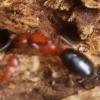I have been searching around on forums and what not, there doesn't seem to be any records of people keeping Camponotus decipiens longer than a couple of years. The one, long term journal I found says their colony reached about a hundred workers then died off. As the brand new guardian of an established Camponotus decipiens (maybe, maybe could be Camponotus sayi) colony of about 70 workers, many, many brood, and of course a queen, I am very curious how I can do my best to ensure many years for them to grow. Does anyone have any knowledge of someone being able to keep this particular species for many years? Does anyone know if I can expect the population to reach more than a few hundred?
I have a nice temperature gradient going on, 86 F / 30 C on one side and 70 F / 21 C on the other side. Any time I moisten the place they tend to just move everything far away from the moistened area, so I think they really do like the formicarium nice and dry.
I think my biggest worry is brumation. While this species has a wide range in the south eastern USA, including Florida where there is practically no winter, we can have fairly cold winters, even snow some years, in Texas. I think brumation will be something I will need to do for them for at least 2 - 3 months. I have no cooler for them though. I figured I would just put them out back on the covered porch but some sources say simply putting a formicarium outside for brumation is a bad idea.
Maybe, just maybe, I might be able to get some kind of cooler before winter but I am looking for any information that I might have missed in my searches or suggestions to consider as I form a plan for keeping the colony going for years to come. I would also love to find a new queen one day and start from the beginning and would like to have an idea if I can mature a colony and have it thrive for years
Any experience y'all can add would be great! Thank you!
Edited by dominatus, May 29 2019 - 9:34 AM.
















